Intel's Ivy Bridge Architecture Exposed
by Anand Lal Shimpi on September 17, 2011 2:00 AM EST- Posted in
- CPUs
- Intel
- Ivy Bridge
- IDF 2011
- Trade Shows
The New GPU
Westmere marked a change in the way Intel approached integrated graphics. The GPU was moved onto the CPU package and used an n-1 manufacturing process (45nm when the CPU was 32nm). Performance improved but it still wasn't exactly what we'd call acceptable.
Sandy Bridge brought a completely redesigned GPU core onto the processor die itself. As a co-resident of the CPU, the GPU was treated as somewhat of an equal - both processors were built on the same 32nm process.
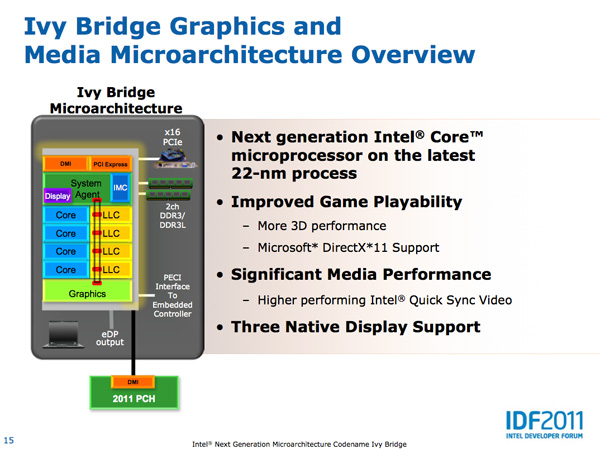
With Ivy Bridge the GPU remains on die but it grows more than the CPU does this generation. Intel isn't disclosing the die split but there are more execution units this round (16 up from 12 in SNB) so it would appear as if the GPU occupies a greater percentage of the die than it did last generation. It's not near a 50/50 split yet, but it's continued indication that Intel is taking GPU performance seriously.
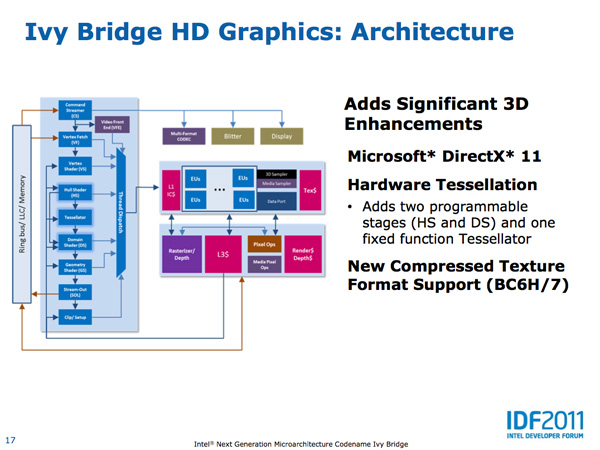
The Ivy Bridge GPU adds support for OpenCL 1.1, DirectX 11 and OpenGL 3.1. This will finally bring Intel's GPU feature set on par with AMD's. Ivy also adds three display outputs (up from two in Sandy Bridge). Finally, Ivy Bridge improves anisotropic filtering quality. As Intel Fellow Tom Piazza put it, "we now draw circles instead of flower petals" referring to image output from the famous AF tester.
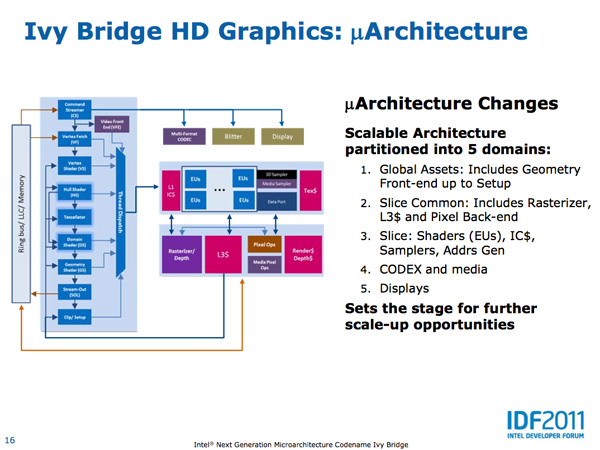
Intel made the Ivy Bridge GPU more modular than before. In SNB there were two GPU configurations: GT1 and GT2. Sandy Bridge's GT1 had 6 EUs (shaders/cores/execution units) while GT2 had 12 EUs, both configurations had one texture sampler. Ivy Bridge was designed to scale up and down more easily. GT2 has 16 EUs and 2 texture samplers, while GT1 has an unknown number of EUs (I'd assume 8) and 1 texture sampler.
I mentioned that Ivy Bridge was designed to scale up, unfortunately that upwards scaling won't be happening in IVB - GT2 will be the fastest configuration available. The implication is that Intel had plans for IVB with a beefier GPU but it didn't make the cut. Perhaps we will see that change in Haswell.
As we've already mentioned, Intel is increasing the number of EUs in Ivy Bridge however these EUs are much better performers than their predecessors. Sandy Bridge's EUs could co-issue MADs and transcendental operations, Ivy Bridge can do twice as many MADs per clock. As a result, a single Ivy Bridge EU gets close to twice the IPC of a Sandy Bridge EU - in other words, you're looking at nearly 2x the GFLOPS in shader bound operations as Sandy Bridge per EU. Combine that with more EUs in Ivy Bridge and this is where the bulk of the up-to-60% increase in GPU performance comes from.
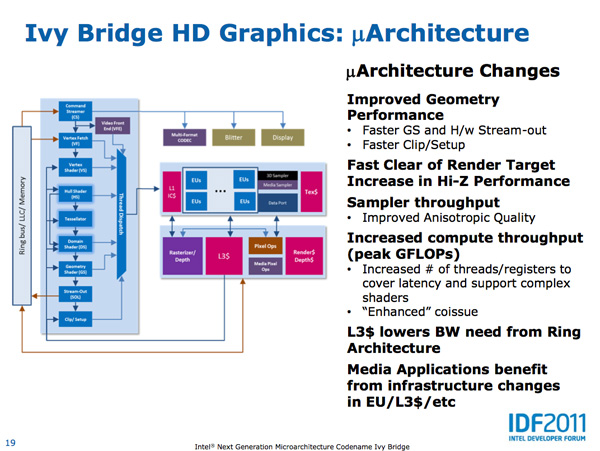
Intel also added a graphics-specific L3 cache within Ivy Bridge. Despite being able to share the CPU's L3 cache, a smaller cache located within the graphics core allows frequently accessed data to be accessed without firing up the ring bus.
There are other performance enhancements within the shader core. Scatter & gather operations now execute 32x faster than Sandy Bridge, which has implications for both GPU compute and general 3D gaming performance.
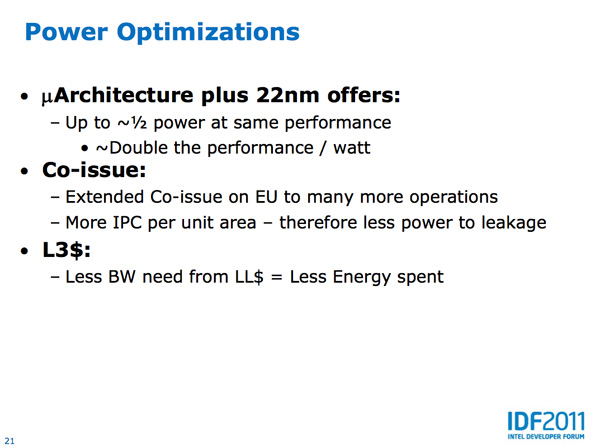
Despite the focus on performance, Intel actually reduced the GPU clock in Ivy Bridge. It now runs at up to 95% of the SNB GPU clock, at a lower voltage, while offering much higher performance. Thanks primarily to Intel's 22nm process (the aforementioned architectural improvements help as well), GPU performance per watt nearly doubles over Sandy Bridge. In our Llano review we found that AMD delivered much longer battery life in games (nearly 2x SNB) - Ivy Bridge should be able to help address this.
Quick Sync Performance Improved
With Sandy Bridge Intel introduced an extremely high performing hardware video transcode engine called Quick Sync. The solution ended up delivering the best combination of image quality and performance of any available hardware accelerated transcoding options from AMD, Intel and NVIDIA. Quick Sync leverages a combination of fixed function hardware, IVB's video decode engine and the EU array.
The increase in EUs and improvements to their throughput both contribute to increases in Quick Sync transcoding performance. Presumably Intel has also done some work on the decode side as well, which is actually one of the reasons Sandy Bridge was so fast at transcoding video. The combination of all of this results in up to 2x the video transcoding performance of Sandy Bridge. There's also the option of seeing less of a performance increase but delivering better image quality.
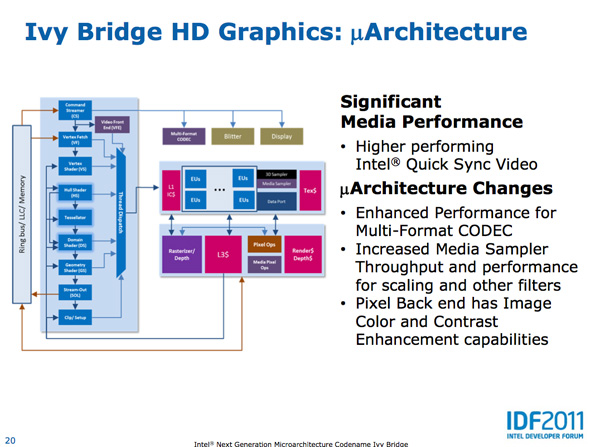
I've complained in the past about the lack of free transcoding applications (e.g. Handbrake, x264) that support Quick Sync. I suspect things will be better upon Ivy Bridge's arrival.
















97 Comments
View All Comments
shiznit - Saturday, September 17, 2011 - link
Intel's APU is more integrated than AMD'sTypeS - Monday, September 19, 2011 - link
Guess you're one of those fanboys that just couldn't come back down from high of AMD's time in the spotlight with the Athlon 64?For someone who speaks of facts, you need to go check the architecture of both the SNB and Llano/Brazo cores before you say AMD has the more integrated approach.
AMD is just using marketing nonsense with calling their new CPU an "APU", just like when they called the Phenom X4s "true quad cores".
JonnyDough - Monday, September 19, 2011 - link
Marketing fluff is Intel's bag, right? Maybe you forget the whole "clock speed" fiasco. Selling P4's claiming they are faster than the competition, although they are not...At least consumers eventually caught on and OEMs began looking at AMD processors as well. :)
You all sound like fanboys though, who really cares who's right? We should just be excited about the TECH!
Kaihekoa - Saturday, September 17, 2011 - link
Lol with Intel's capital and recruiting experienced GPU engineers that "two year lead" will evaporate faster than boiling water. I don't know where you're getting your delusions of the mainstream market sapping up AMD's CPU/GPU combination marketing and products, but the average computer user doesn't use or need anything more than Intel's current generation of graphics. And as others have mentioned Intel's design is more integrated than AMDs on an engineering/design level.Yes, they have the more powerful GPU, but you have to be an idiot to think it's more integrated than Ivy Bridge. CPU performance and graphics good enough to power 2D and 3D accelerated media are the yardstick for PC performance for the vast majority of users. You're truly deluding yourself if you think the average computer user is playing The Witcher 2 and Deus Ex on their PCs with cards more powerful than IVB's. Even now with AMD's two year advantage, guess who owns the market for systems with a combined CPU/GPU? For integrated graphics? Wintel.
Am I an Intel fanboy? No, the last desktop system I built had an AMD CPU and discrete GPU, but you can't logically deny how well their business is doing now, and you'd be a food to think they would overlook the mainstream demand for a high-end APU. In the future when the market needs/wants it, Intel will have something equivalent or better to AMD/ATI.
Zoomer - Saturday, September 17, 2011 - link
Let's not forget drivers and game support, not to mention IQ. Last I checked, Intel graphics drivers were still pretty horrible.iwodo - Sunday, September 18, 2011 - link
Exactly. Designing Hardware is easy. You throw Money and Engineers you could be there in no time. Especially with the expertise from Intel.Software - on the other hand, takes time. No matter how many engineers you put in. Drivers is the problems Intel has to overcome.
JonnyDough - Monday, September 19, 2011 - link
I agree. Software is key. Intel is good at parts of it, AMD is better when it comes to keeping up with game developers. However, business markets make enthusiast markets look miniscule. Still, both are great competitors and we consumers just keep winning. :)iwodo - Sunday, September 18, 2011 - link
I forgot to add, there is a reason why Nvidia has more Software Engineers then Hardware.medi01 - Sunday, September 18, 2011 - link
It's actually the other way round. Pretty much any CPU starting from about 2008 is "more than good enough" for most users.BSMonitor - Sunday, September 18, 2011 - link
"In spite of the marketing hype from Intel it looks like they've conceded that AMD has the better system approach with APUs for mainstream consumers and laptops. CPU performance alone is no longer a valid yardstick for PC performance thanks to AMD's advance thinking and Llano. "This is utter nonsense. All AMD has done is transfer 400 of its shader units on to the CPU core. What you have with AMD is a 4-5 year old GPU combined with a 3 year old CPU.
Both sides of the coin yeild a huge YAWN from anyone looking for real performance.